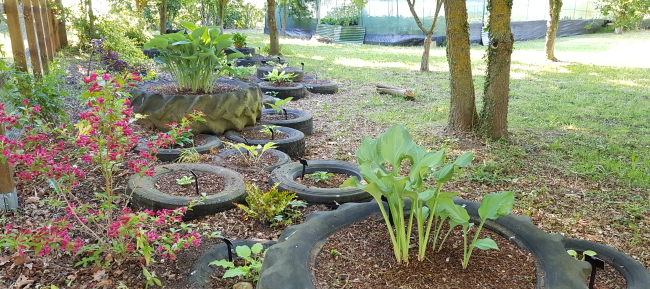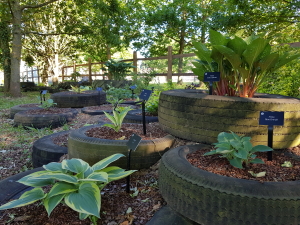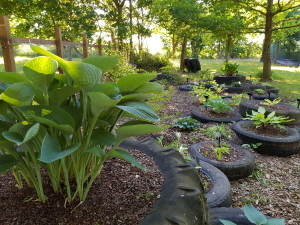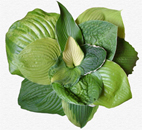Reservoir garden
Back in September 2018 we decided to turn our redundant reservoir (the area within the yellow rectangle in the photo below) into an exhibition garden...

This photo, taken during the summer 2017, clearly shows just how overgrown the reservoir was, with willow and bramble, among other invasive plant life. It has been home to a variety of wildlife, some of which we wish to continue to support. Others need to move out, such as foxes, badgers and muntjac deer.
Following successive dry years, the reservoir finally dried out completely in the summer of 2020 only to half fill again over the following winter. The work we started back in 2018 has successfully lessened demand on the water we naturally capture and, as we no longer extract for watering purposes, the water level is likely to remain quite high unless we get another series of dry years. The wildly fluctuating water level poses a problem with the plans to turn the reservoir into a garden so we have made the decision to abandon this plan and manage the space as a wildlife haven and occasional water resource in very dry times.
If you would like to know what the original plans were then take a look at the following:
A new arboretum and hosta garden in the north field
When we returned to the drawing board to discuss what to do about a garden we decided to go with a long held desire to create a wood in the 2 hectare north field. Knowing this would be a really long term project we continued with the clearance work we had begun back in 2018. Up to the start of the pandemic we had been very pushed to maintain anything of the previous clearance work so David had to start over with much of the clearance but he found it much easier to clear back the most recent growth and lock-down meant he could continue that throughout the summer. 2020 was a very dry year up to the autumn and then someone turned on the tap and it didn't stop raining until well into 2021. This left us unable to get onto the land and do any structural work for many months.
Undeterred David has made excellent headway and then in June we had a speculative application to Mid Suffolk District Council, for funding to fence our boundaries currently open to farmland and to purchase trees for the arboretum planned for the north field, approved.
We have purchased quite a lot of trees, both for the arboretum and the windbreak needed for the boundary. We also have a stack of fencing ready for when we have cleared the boundary of dead and dying tress and scrub hedges. This clearance was going well, however, successive periods of extreme wet and dry meant that we had to abandon the work for around two years.
We have recently resumed the work, see the November 2023 newsletter, but only briefly as it appears we are suffering another wet autumn. We will provide further updates when there is more to report.
Rubber Rockery
This element of the nursery garden
is located in the south field, near to the collection tunnels.
It is like a history of the nursery in tyres, all with a story to tell but now recycled into a hosta bed. It is an experiment to see if the tyres help isolate the plants from pests and provide a good environment in which to grow hosta, and so far it is working well:
 |
We have recently been able to label the majority of the plants used in the rockery with some fabulously sturdy and attractive labels from our local Plant Heritage Group.
 |
 |
The red-stemmed variety in the photo above is H. 'Celtic Uplands'.
Why not view the Rubber Rockery video where we take a tour of all the plants used in the tyres. During 2021 we added and moved a number of plants to this area.
In the spring of 2023 we decided to remove the plants and abandon this feature as it is essentially in the wrong place. The leaky pipe and top up watering were still no match for the drought conditions we suffered in 2022, the water table dropped to the lowest level since 1976 and so the only planting that could cope were the trees, which have continued to dominate this area of the nursery.
We have decided to thin out the trees and leave them to dominate as a small wood.
The tyres are still in situ but we may move them into the north field at some point and start again, as the experiment was working well. Yet again the weather is forcing us to be flexible with our plans. |





